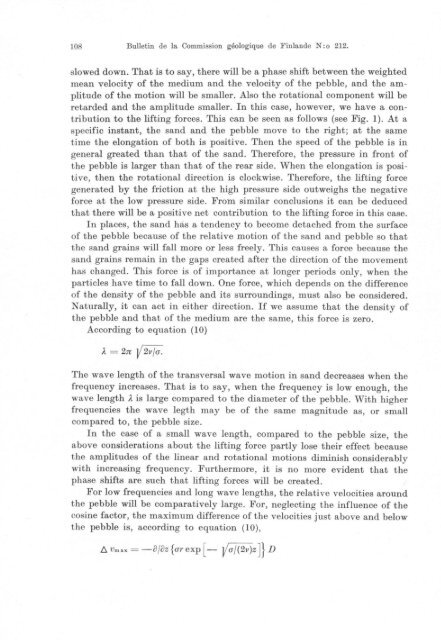COMMISSION GEOLOGIOUE - Arkisto.gsf.fi
COMMISSION GEOLOGIOUE - Arkisto.gsf.fi
COMMISSION GEOLOGIOUE - Arkisto.gsf.fi
You also want an ePaper? Increase the reach of your titles
YUMPU automatically turns print PDFs into web optimized ePapers that Google loves.
108 Bulletin de la Commission geologique de Finlande N: 0 212.<br />
slowed down. That is to say, there will be a phase shift between the weighted<br />
mean velo city of the medium and the velo city of the pebble, and the amplitude<br />
of the motion will be smaller. Also the rotational component will be<br />
retarded and the amplitude smaller. In this case, however, we have a contribution<br />
to the lifting forces. This can be seen as follows (see Fig. 1). At a<br />
speci<strong>fi</strong>c instant, the sand and the pebble move to the right; at the same<br />
time the elongation of both is positive. Then the speed of the pebble is in<br />
general greated than that of the sand. Therefore, the pressure in front of<br />
the pebble is larger than that of the rear side. When the elongation is positive,<br />
then the rotational direction is clockwise. Therefore, the lifting force<br />
generated by the friction at the high pressure side outweighs the negative<br />
force at the low pressure side. From similar conclusions it can be deduced<br />
that there will be a positive net contribution to the lifting force in this case.<br />
In places, the sand has a tendency to become detached from the surface<br />
of the pebble because of the relative motion of the sand and pebble so that<br />
the sand grains will fall more or less freely. This causes a force because the<br />
sand grains remain in the gaps created after the direction of the movement<br />
has changed. This force is of importance at longer periods only, when the<br />
particles have time to fall down. One force, which depends on the difference<br />
of the density of the pebble and its surroundings, must also be considered.<br />
Naturally, it can act in either direction. If we assume that the density of<br />
the pebble and that of the medium are the same, this force is zero.<br />
According to equation (10)<br />
A = 2n V2v/a.<br />
The wave length of the transversal wave motion in sand decreases when the<br />
frequency increases. That is to say, when the frequency is low enough, the<br />
wave length A is large compared to the diameter of the pebble. With higher<br />
frequencies the wave legth may be of the same magnitude as, or small<br />
compared to, the pebble size.<br />
In the case of a small wave length, compared to the pebble size, the<br />
above considerations about the lifting force partly lose their effect because<br />
the amplitudes of the linear and rotational motions diminish considerably<br />
with increasing frequency. Furthermore, it is no more evident that the<br />
phase shifts are such that lifting forces will be created.<br />
For low frequencies and long wave lengths, the relative velocities around<br />
the pebble will be comparatively large. For, neglecting the influence of the<br />
eosine factor, the maximum difference of the velocities just above and below<br />
the pebble is, according to equation (10),<br />
~ Vmn = -%z {a1' exp [- va/(2v)z J} D
















